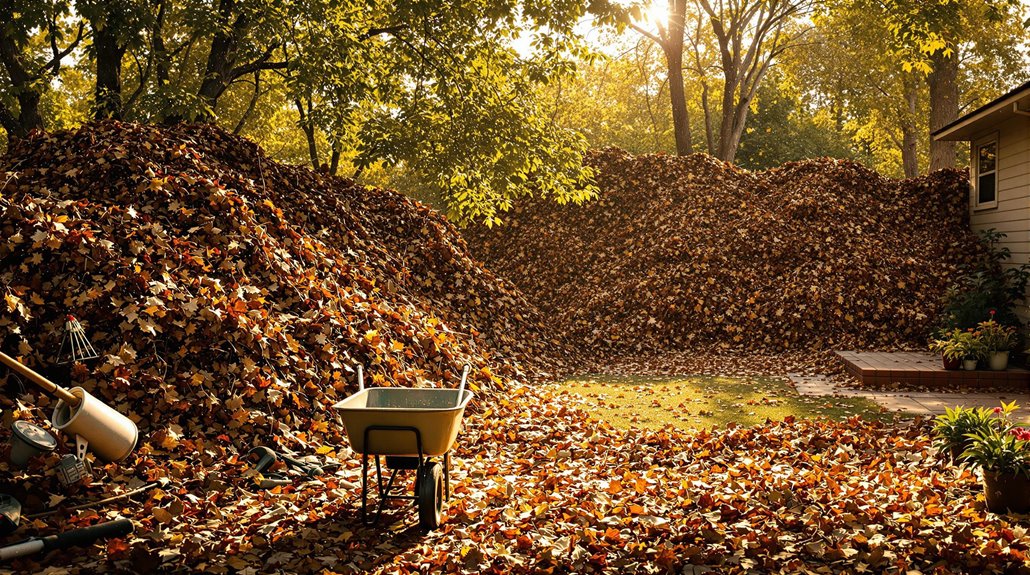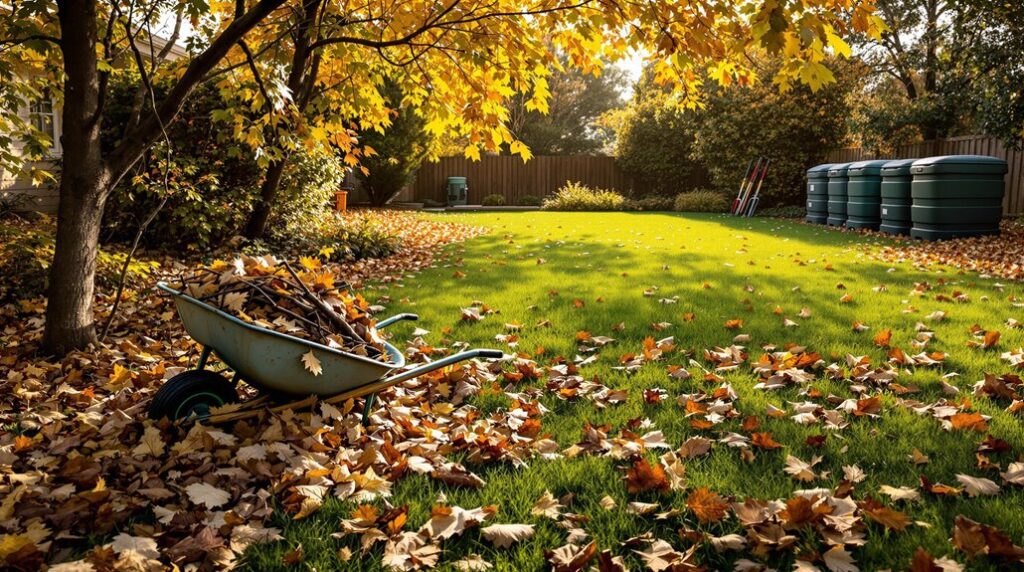Homeowners can reclaim space from overwhelming yard waste through several practical approaches. Municipal collection services, drop-off facilities, and dumpster rentals offer external solutions, while in-place mulching and composting transform debris into valuable resources. Creating designated collection areas, implementing seasonal maintenance schedules, and practicing proper mulching techniques greatly reduce accumulation. A systematic approach not only frees up physical space but also contributes to a more sustainable landscape that requires fewer inputs and generates less waste overall.
Understanding Your Yard Waste Footprint

What happens to those piles of grass clippings, fallen leaves, and trimmed branches after yard work is complete? These materials constitute a significant portion of municipal solid waste—33.4 million tons annually or about 216 pounds per person each year. Grass clippings alone make up half of all yard waste by weight.
Your yard waste impact varies by season and region. In the Northeast and Midwest, denser vegetation and colder climates generate more yard debris. During peak growing seasons, grass clippings can represent up to 50% of household waste.
At such times sent to landfills, yard waste contributes to methane emissions—a greenhouse gas 25 times more potent than carbon dioxide. While 57.5% of yard waste is composted nationwide, 14.2 million tons still end up in landfills, where it triples in density when compacted.
Space-Saving Solutions for Yard Debris Management
Managing yard debris effectively requires strategic approaches that maximize available space while minimizing environmental impact. Homeowners can reclaim their yards through strategic disposal methods tailored to their specific needs.
Smart yard debris management balances space optimization with eco-friendly practices, helping homeowners reclaim their outdoor areas.
- Municipal collection services offer scheduled pickups using biodegradable bags or approved containers, eliminating on-site storage concerns.
- Drop-off recycling facilities accept various yard waste types, with branch bundling requirements for easier transport.
- Dumpster rentals provide one-time bulk disposal for major cleanups, eliminating multiple transport trips.
- In-place mulching transforms grass clippings and leaves into natural fertilizer directly on lawns.
For ideal space management, residents should understand local restrictions regarding acceptable materials and volume limits. Timing cleanups to align with collection schedules prevents accumulation, while separating waste types ensures compliance with facility standards and maximizes recycling opportunities.
Turning Yard Waste Into Valuable Resources

Yard waste represents an untapped resource that many homeowners overlook while cleaning their properties. Through strategic composting, anyone can transform leaf piles and grass clippings into nutrient-rich soil by maintaining a 2:1 ratio of green to brown materials. Shredding leaves and chipping branches accelerates decomposition while improving aeration.
Kitchen scraps combined with yard debris create balanced compost with improved fertilizing potential. For larger items such as tree stumps, low-and-slow composting methods allow gradual breakdown into usable humus. Homeowners can also repurpose yard waste into protective mulch that suppresses weeds and retains moisture around plants.
Setting Up a Sustainable Yard Maintenance System
Establishing a sustainable yard maintenance system begins with a holistic approach that balances ecological principles and practical needs. Homeowners can implement practices that reduce waste while enhancing their landscape’s health. This approach minimizes chemical dependency and maximizes resource efficiency.
Creating sustainable yards requires balancing ecology and practicality to reduce waste, enhance landscapes, and minimize chemical dependencies.
To create a maintenance system that works with nature:
- Set up a designated composting area for yard debris, transforming waste into valuable soil amendments
- Install rainwater collection systems near high-water-use zones to reduce municipal water consumption
- Create zones based on plant water and maintenance needs, grouping similar species together
- Develop a seasonal maintenance calendar that works with natural cycles rather than against them
These strategies create a self-sustaining ecosystem that requires fewer inputs while producing healthier, more resilient outdoor spaces.
Frequently Asked Questions
Can Yard Waste Attract Pests if Improperly Managed?
Yes. Yard waste piles provide shelter, food, and breeding sites for rodents, insects, and snakes when not properly managed.
How Do HOA Regulations Affect Yard Waste Management Options?
HOA regulations limit yard waste handling through:
- Collection schedules
- Designated disposal areas
- Required bundling methods
- Approved container specifications
- Permitted disposal procedures
Violations incur fines. Some HOAs provide shared composting sites.
What Equipment Is Essential for Efficient Yard Waste Processing?
Yard waste processing requires:
- Shredders
- Chippers
- Mulching mowers
- Compost bins
- Wheelbarrows
- Twine for bundling
- Collection containers
Are There Seasonal Considerations for Different Types of Yard Waste?
Spring yard waste includes pruning debris and dead plants. Summer waste consists of grass clippings and storm-damaged branches. Each requires specific disposal methods.
How Do Weather Patterns Impact Yard Waste Decomposition Rates?
Heat speeds decomposition unless materials dry out. Cold slows microbial breakdown. Excess rain leaches nutrients. Wind reduces oxygen flow and contaminates compost piles.
References
- https://www.waste360.com/yard-waste/profiles-in-garbage-yard-waste-8015
- https://www.178wing.ang.af.mil/Portals/69/documents/afh33-337.pdf?ver=2016-12-15-101008-313
- https://www.epa.gov/facts-and-figures-about-materials-waste-and-recycling/national-overview-facts-and-figures-materials
- https://www.cag.edu.tr/uploads/site/lecturer-files/387-2-english-vocabulary-in-use-pre-intermediate-and-intermediate-redman-2017-4th-264p-sayfalar-silindi-3br9.pdf
- https://dep.nj.gov/wp-content/uploads/dsr/trends-solid-waste-recycling.pdf
- https://www.waste360.com/yard-waste/profiles-in-garbage-yard-waste-10847
- https://todayshomeowner.com/lawn-garden/guides/the-complete-guide-to-yard-waste-disposal/
- https://www.waste360.com/yard-waste/yard-waste-collection-spreads-branches-of-growth
- https://veransa.com/how-to-responsibly-dispose-of-yard-waste/
- https://troupewaste.com/how-to-get-rid-of-yard-waste-in-effective-ways/

